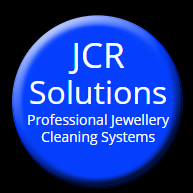JCR In-Store Jewellery Cleaning System Advanced Troubleshooting Guide
The following tables are for advanced troubleshooting and problem solving when using the Ion-Stream Commercial.
Unpatinated bright polished surfaces
Appearance or Issue
Probable cause and recommendations to resolve the problem
Yellow to dark brown patches and staining
It is possible that residues left by previous chemical cleaning could cause staining particularly in folds, stone settings, hollows etc. It is conceivable that the residue of these chemicals will leach out during cleaning with the JCR process complicating and contaminating the solution.
If the item has been cleaned using chemicals, we recommend that the item has an initial cleaning of at least two 40 sec cycles followed by gentle brushing and a thorough rinse in clean water. Subsequent cleans will only require a 2 or 3 second dip followed by thorough rinse.
Dull or scratched surface
It is not possible for the JCR System to damage the surface.
Previous damage will be revealed once the surface has been cleaned.
Damage can be caused by chemical cleaning dips and impregnated polishing cloths. Chemical dips are usually acidic and very reactive. They will damage the polished surface, eroding it microscopically each time it is done. Polishing cloths will pick up large abrasive particles and oil from handling and can scratch fine surfaces.
Yellow patches left around stones
This could be as a result of chemicals leaching out of the setting as described above. This will be cleared by initially giving the item two or three cycles of 30 seconds, and then brushing with the washout brush supplied. Subsequent cleans will only need two or three seconds of processing.
Black in crevices
An initial cleaning will be needed using two or three 40 second cycles then brush gently with the washout brush, rinse in distilled water and pat dry. Subsequent cleans will take only two or three seconds.
The item can be placed in an ultrasonic tank if preferred to brushing.
Replace the electrolyte frequently when undertaking initial cleaning.
Burn marks
The JCR uses only a very small amount of electrical energy and this is regulated according to the size of the surface area. This means it cannot burn, so this effect must be another artefact from the process or previous processes. It is possible that this staining may appear between the links, as these areas will be the most tarnished. It is also possible that chemicals from previous cleaning regimes have remained in those hard to reach areas. Give these items an initial clean of two to three 30 second cycles. Gently use a washout brush with a brushing medium to remove marks. If an ultrasonic tank is available, place the JCR bath in the ultrasonic tank, switch it on and cycle the item simultaneously in the electrolyte. Subsequent cleans will take only two or three seconds.
Insufficient cleaning of the surface
If particularly stubborn, gently brush with brushing medium, rinse in distilled water and dry with a soft cloth. Subsequent cleans will take only two or three seconds and no brushing will be needed
Very tarnished items not coming up white and bright
These items will clean perfectly, needing one to three cycles depending on the level of tarnish. In this case the surface will need to be brushed gently with the washout brush supplied. This will remove the loosened lattice that is weakly attached to the surface. This can also be done by placing the JCR bath in an ultrasonic bath, and simultaneously dipping and processing the dirty item. This is particularly effective on chains and matted surfaces. In extreme cases the item can be gently brushed with a non-toxic brushing medium. Subsequent cleans will only take two or three seconds and no brushing will be required.
Patinated bright polished surfaces
Appearance or Issue
Probable cause and recommendations to resolve the problem
Yellow to brown staining on bright silver surface
When chemically patinated pieces are processed by the JCR system, metal ions will be released from the blackening chemicals into the electrolyte solution. If the concentration is allowed to build up, the metal ions will plate out onto the surface of the item being cleaned. It will be seen as a yellow to black stain. This is not a problem on the dark areas, but is undesirable on the bright polished areas. Fortunately, the silver dipping hook will act as an indicator as its normally white surface will become coloured.
There will be a build up of contaminants in the electrolyte solution, as described above, and this is unavoidable. It is vitally important to keep the solution fresh. Keep the dipping hook clean as it will show a mild discolouration if there is a problem with the solution.
Should the bright surface of the jewellery or dipping hook become coloured it can be simply wiped with a soft cloth charged with a little fine jewellers rouge. The electrolyte solution will need to be changed much more frequently than when cleaning untreated surfaces. Experience of the process will provide a guide as to when the solution is replaced.
